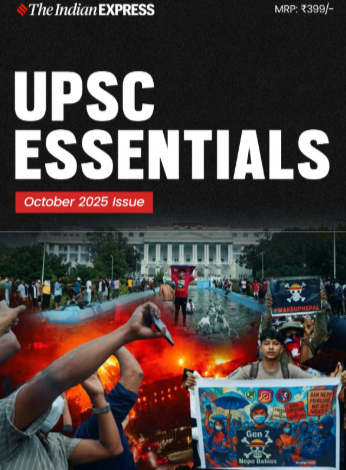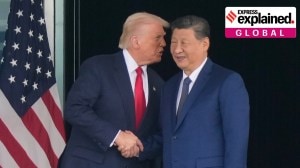Manas Srivastava leads the UPSC Essentials section of The Indian Express (digital). He majorly writes on UPSC, other competitive exams and education-related projects. In the past, Manas has represented India at the G-20 Youth Summit in Mexico. He is a former member of the Youth Council, GOI. A two-time topper/gold medallist in History (both in graduation and post-graduation) from Delhi University, he has mentored and taught UPSC aspirants for more than five years. His diverse role in The Indian Express consists of writing, editing, anchoring/ hosting, interviewing experts, and curating and simplifying news for the benefit of students. He hosts the YouTube talk show called ‘Art and Culture with Devdutt Pattanaik’ and a LIVE series on Instagram and YouTube called ‘LIVE with Manas’.His talks on ‘How to read a newspaper’ focus on newspaper reading as an essential habit for students. His articles and videos aim at finding solutions to the general queries of students and hence he believes in being students' editor, preparing them not just for any exam but helping them to become informed citizens. This is where he makes his teaching profession meet journalism. He is also the editor of UPSC Essentials' monthly magazine for the aspirants. He is a recipient of the Dip Chand Memorial Award, the Lala Ram Mohan Prize and Prof. Papiya Ghosh Memorial Prize for academic excellence. He was also awarded the University’s Post-Graduate Scholarship for pursuing M.A. in History where he chose to specialise in Ancient India due to his keen interest in Archaeology. He has also successfully completed a Certificate course on Women’s Studies by the Women’s Studies Development Centre, DU. As a part of N.S.S in the past, Manas has worked with national and international organisations and has shown keen interest and active participation in Social Service. He has led and been a part of projects involving areas such as gender sensitisation, persons with disability, helping slum dwellers, environment, adopting our heritage programme. He has also presented a case study on ‘Psychological stress among students’ at ICSQCC- Sri Lanka. As a compere for seminars and other events he likes to keep his orating hobby alive. His interests also lie in International Relations, Governance, Social issues, Essays and poetry. ... Read More
UPSC Essentials | Weekly news express with MCQs: 7% GDP, salt cavern-based reserves, and more
The Indian Express’ UPSC weekly news express covers some of the important and burning topics of current affairs news from this week to help you prepare for UPSC-CSE. Try out the MCQs and check your answers provided towards the end of the article.
 FM Niramala Sitharman said the country's economy is on the right track and heading towards a bright future despite all the challenges. Expected GDP is a part of our weekly news express today. ( Representational)
FM Niramala Sitharman said the country's economy is on the right track and heading towards a bright future despite all the challenges. Expected GDP is a part of our weekly news express today. ( Representational) The Indian Express’ UPSC weekly news express covers some of the important and burning topics of current affairs news from this week to help you prepare for UPSC-CSE. Try out the MCQs and check your answers provided towards the end of the article.
Probe panel for Manipur violence
WHY IN NEWS?
— Union Home Minister Amit Shah on Thursday (June 1) announced that a probe panel led by a retired High Court judge will investigate the recent violence in Manipur that led to the death of at least 80 people and left several injured. He said the reasons behind the month-long bout of violence and those responsible for it will be probed.
— Shah held a press conference towards the end of his four-day visit in the state that began on May 29, and announced several measures for the state. He met victims from both the Meitei and Kuki communities of the state a day earlier in relief camps, assuring them of adequate security, and said the government’s focus is to ensure their safe return home.
KEY TAKEAWAYS
What is happening in Manipur?
— Ethnic clashes broke out in the state nearly a month ago after a ‘Tribal Solidarity March’ was organised in the hill districts to protest the Meitei community’s demand for Scheduled Tribe (ST) status.
— The trigger for the violent clashes was a contentious order of the Manipur High Court that boosted a longstanding demand by the valley-dwelling Meiteis to be designated as a ST in order to protect their “ancestral land, traditions, culture and language”. Protests by tribal groups such as the Kukis against the HC order in all the hill districts on May 3 led to violence, first in Kuki-dominated Churachandpur, and then in the Imphal valley.
— After a relative lull for over a fortnight, the state witnessed a spurt in clashes and gunfights between militants and security forces on Sunday. Officials in Manipur on Sunday said that there had been a direct confrontation between armed militants and the Manipur Police in five different areas on the outskirts of Imphal Valley.
— Amid ethnic tension in the state, IPS officer Rajiv Singh of the Tripura cadre (1993 batch), was given charge of the post of Director General of Police (DGP) in Manipur on May 29.
What has Amit Shah announced regarding the situation in Manipur?
— Shah said during his visit he went to temporary shelters, he visited Imphal, Moreh, Churachandpur, and Kangpokpi, and spoke to cabinet members, leaders of 11 political organisations, women’s organisations, Meitiei and Kuki civil society organisations, professors and retired officers. Apart from the formation of the probe panel, he announced some other measures:
* Under the chairmanship of Manipur governor Anusuiya Uikey, the Indian government will form a peace committee which will have “representation of everyone – industrialists, sportspersons, political parties representatives, elected representatives and those from civil society organisations,” he said.
* For better coordination between security agencies in the state, security advisor Kuldiep Singh, Director General of the Central Reserve Police Force, will oversee an inter-agency unified command.
* Of the cases of violence that have been registered, six have been selected for investigation by a special CBI team. This includes one case for the charge of general conspiracy.
* A relief and rehabilitation package has been readied. For every person who has lost their life, Rs 10 lakhs will be given (with half of the amount by the Central government and the other by the Manipur government). Their family members will receive it via Direct Benefit Transfer (DBT) into their bank accounts. For those who have been injured or suffered a loss of property, a detailed announcement on this will come from the Central government tomorrow.
* A Joint Secretary-level officer and five Director-level officers will be present here to monitor these works.
* Fencing of around 10 km of the Myanmar-Manipur border has been done and tendering has been done for 80 km of the border. The survey work for the rest of its length will be started. Biometric and eye scans of those coming from abroad will be carried out, so that there is no “violence caused by instigation,” the Minister said.
* Shah said 30,000 metric-tonne of rice will be provided to Manipur for the next two months. Gas, petrol and vegetables will also be brought in. For their distribution, along with existing shops selling cheaper grains, a camp will also be opened where people can get food items through both ration cards and by purchasing them. Medicines will be made available here. Some 15 petrol pumps will be kept open during the night and day.
* To address the issues of holding competitive exams and to keep educational institutions going, a plan is also being formulated and will be out in two days. Options such as online education are being discussed. For courts too, virtual hearings and appearances are being planned.
* From Moreh, Churachandpur and Kangpokpi, a helicopter service will help in transportation, at the cost of Rs 2,000 per person to take people to the airport. The cost will be borne by the state and central government.
(Source: Manipur violence:What measures has Home Minister Amit Shah announced for the state?)
Point to ponder: Why violence in Manipur a dangerous precedent?
1. MCQ:
Which of the following statements is not true with reference to Manipur?
(a) Loktak lake is located in Manipur.
(b) Manipur is bounded by four Indian states.
(c) Meitei people represent the majority population of Manipur.
(d) Manipur is represented by only one member in Rajya Sabha.
India’s GDP expected to cross 7 per cent
WHY IN NEWS?
— Despite the global slowdown caused by Covid-19 and Russia-Ukraine war, Indian economy is expected to grow at 7 per cent in fiscal 2022-23 – the highest rate of growth among all major economies, Finance Minister Nirmala Sitharaman said on Wednesday. She said the country’s economy is on the right track and heading towards a bright future despite all the challenges.
— However, the Centre’s GDP growth projection for FY23 is slightly higher than the Reserve Bank of India’s (RBI) real GDP growth estimate of 6.8 per cent for the current fiscal. “Our vision for the Amrit Kaal includes technology-driven and knowledge-based economy with strong public finances, and a robust financial sector. To achieve this, Jan Bhagidari through Sabka Saath Sabka Prayas is essential,” Sitharaman said.
KEY TAKEAWAYS
Hitesh Vyas , Sukalp Sharma Explain:
— The economic agenda for achieving this vision focuses on three things – facilitating ample opportunities for citizens, especially the youth; providing strong impetus to growth and job creation, and strengthening macro-economic stability, she said.
— As per the First Advance Estimates of National Income for 2022-23, India’s real GDP and nominal GDP are projected to grow by 7 per cent (y-o-y) and 15.4 per cent (y-o-y), respectively. For 2023-24, the Union Budget has projected nominal GDP growth at 10.5 per cent.
— While speaking to reporters in a post-Budget press conference, Finance Secretary TV Somanathan said, “Our number of 10.5 per cent (growth in nominal GDP for FY2024) could come from any combination of inflation and real growth. We are reasonably confident that we will exceed 10.5 per cent nominal growth for the purposes of estimating our revenue.” To push growth further, the Centre has increased the capital investment outlay steeply for the third year in a row by 33 per cent to Rs 10 lakh crore, or 3.3 per cent of GDP, for fiscal 2023-24.
“This substantial increase in recent years is central to the government’s efforts to enhance growth potential and job creation, crowd in private investments, and provide a cushion against global headwinds,” the Finance Minister added.
— In the last nine years, she said, the Indian economy has increased in size from being 10th to 5th largest in the world. It has significantly improved its position as a well-governed and innovative country with a conducive environment for business as reflected in several global indices, she added.
“The economy has become a lot more formalised as reflected in the EPFO membership more than doubling to 27 crore, and 7,400 crore digital payments of Rs 126 lakh crore through UPI in 2022,” she said.
— On inflation, Sitharaman said inflation has already moderated to some extent due to the measures taken by the government and RBI. The government does not “look the other way” when inflation is high and it has “kept attending to” the problem of high inflation, she added.
— In December, the Consumer price-based inflation (CPI), or retail inflation, eased to 5.72 per cent from 5.88 per cent in November.
High GDP numbers show momentum in the economy. But keeping up the pace will be a challenge. Why?
As per Indian Express’ Editorial:
— The disaggregated data points towards a healthy growth momentum across most sectors. The agricultural sector grew at a robust 5.5 per cent in the fourth quarter, with growth for the full year estimated at 4 per cent. Within the non-farm sector, manufacturing, which had contracted in both the second and third quarter, turned around in the fourth quarter. Analysts have attributed this pick up to an improvement in both volumes and margins.
— Alongside, construction, another labour intensive sector, has also registered a healthy performance, with growth for the full year being estimated at 10 per cent. Within services, the trade, hotels, transport and communications sector has maintained its growth momentum, while the financial, real estate and professional services sector has seen a sustained pickup over the year.
— However, the continuing weakness in private consumption is difficult to reconcile. Private consumption grew by only 2.8 per cent in the fourth quarter, marginally higher than 2.2 per cent in the third quarter, reflecting in part the subdued performance of the consumer durables segment in the index of industrial production.
— Government consumption has also remained weak, though, on the other hand, investment activity continued to be healthy (mirroring the performance of the capital goods and infrastructure segments in the index of industrial production), while net exports were less of a drag. Over the course of the coming year, the growth momentum is likely to come under pressure as the full impact of tighter global and domestic financial conditions is felt.
— There are also concerns over the monsoon and its impact on rural demand. In its last monetary policy committee meeting, the RBI had forecasted the Indian economy to grow at 6.5 per cent in 2023-24. Others are, however, more pessimistic.
(Source: Economy on right track; to grow at 7% in FY23 FM —Nirmala Sitharaman by Hitesh Vyas , Sukalp Sharma and Express View on GDP numbers— Beating expectation)
Point to ponder: Why India has no choice but to grow faster than other countries?
2. MCQ:
A decrease in tax to GDP ratio of a country indicates which of the following? (2015)
(1) Slowing economic growth rate
(2) Less equitable distribution of national income
Select the correct answer using the code given below.
(a) 1 only
(b) 2 only
(c) Both 1 and 2
(d) Neither 1 nor 2
Salt cavern-based strategic oil reserves
WHY IN NEWS?
— Government-owned engineering consultancy firm Engineers India (EIL) is studying the prospects and feasibility of developing salt cavern-based strategic oil reserves in Rajasthan, in line with the government’s objective of increasing the country’s strategic oil storage capacity.
KEY TAKEAWAYS
Sukalp Sharma Explains:
— If the idea comes to fruition, India could get its first salt cavern-based oil storage facility. The country’s three existing strategic oil storage facilities — at Mangaluru and Padur in Karnataka, and Visakhapatnam in Andhra Pradesh — are made up of excavated rock caverns.
— Countries build strategic crude oil reserves to mitigate major supply disruptions in the global supply chain. India, the world’s third-largest consumer of crude, depends on imports for more than 85 per cent of its requirement — and strategic petroleum reserves (SPR) could help ensure energy security and availability during global supply shocks and other emergencies.
— India currently has an SPR capacity of 5.33 million tonnes, or around 39 million barrels of crude, that can meet around 9.5 days of demand. The country is in the process of expanding its SPR capacity by a cumulative 6.5 million tonnes at two locations — Chandikhol in Odisha (4 million tonnes) and Padur (2.5 million tonnes).
— India’s strategic oil reserves come under the Petroleum Ministry’s special purpose vehicle Indian Strategic Petroleum Reserve (ISPRL). EIL was instrumental in setting up the country’s existing SPR as the project management consultant.
— Salt cavern-based storage, which is considered cheaper and less labour- and cost-intensive than rock caverns, could add a new, much needed chapter to India’s SPR story.
Salt cavern-based reserves v. rock cavern-based reserves
— Unlike underground rock caverns, which are developed through excavation, salt caverns are developed by the process of solution mining, which involves pumping water into geological formations with large salt deposits to dissolve the salt. After the brine (water with dissolved salt) is pumped out of the formation, the space can be used to store crude oil. The process is simpler, faster, and less cost-intensive than developing excavated rock caverns.
— Salt cavern-based oil storage facilities are also naturally well-sealed, and engineered for rapid injection and extraction of oil. This makes them a more attractive option than storing oil in other geological formations, according to a report by the Environmental Solutions Initiative at the Massachusetts Institute of Technology (MIT).
— The salt that lines the inside of these caverns has extremely low oil absorbency, which creates a natural impermeable barrier against liquid and gaseous hydrocarbons, making the caverns apt for storage. Also, unlike rock caverns, salt cavern-based storages can be created and operated almost entirely from the surface.
— The entire SPR programme of the United States has so far been based on salt cavern-based storage facilities. The US Strategic Petroleum Reserve, the world’s largest emergency oil storage, consists of four sites with deep underground storage caverns created in salt domes along the Gulf of Mexico coast in Texas and Louisiana. The US strategic oil reserves have a cumulative capacity of around 727 million barrels.
— Salt caverns are also used to store liquid fuels and natural gas in various parts of the world. They are also considered suitable for storing compressed air and hydrogen.
Potential in India for storing crude, petroleum products
— Rajasthan, which has the bulk of requisite salt formations in India, is seen as the most conducive for developing salt cavern-based strategic storage facilities. Plans over the past decade to build a strategic oil reserve in Bikaner did not take off — and EIL’s Chairman and Managing Director Vartika Shukla said the exploration of the possibility of salt cavern-based strategic storage in Rajasthan can be seen as a renewal of that proposal.
— A refinery is coming up in Barmer, and Rajasthan has crude pipelines as well; such infrastructure is conducive for building strategic oil reserves. However, no Indian company, including EIL, had the requisite technical know-how to build salt cavern-based strategic hydrocarbon storage. This gap in access to technology has been bridged by EIL’s recent partnership with Germany’s DEEP.KBB GmbH — a company that specialises in cavern storage and solution mining technology — Shukla said.
— However, it is still too early to identify a specific site or make an estimate of the project cost, she said. “Once the technology or knowledge is there, only then can we have estimates as to what kind of costs will be involved, and there are so many other factors as well. There will be many steps to project approval… But it is important that India gets that technology, EIL gets that technology to…get an estimate and see how feasible it is,” Shukla said.
Strategic petroleum reserves programme
— India’s strategic oil reserves are part of the effort to build sufficient emergency stockpiles on the lines of the reserves that the US and its Western allies set up after the first oil crisis of the 1970s. The three existing rock cavern-based facilities were built during the first phase of the programme.
— Crude oil from the reserves are to be released by an empowered committee set up by the government, in the event of supply disruptions due to a natural calamity or an unforeseen global event leading to an abnormal increase in prices.
— The International Energy Agency (IEA), a Paris-based autonomous intergovernmental organisation in which India is an ‘Association’ country, recommends that all countries should hold an emergency oil stockpile sufficient to provide 90 days of import protection.
— In India, apart from the SPR that are sufficient to meet 9.5 days of oil requirement, the oil marketing companies (OMCs) have storage facilities for crude oil and petroleum products for 64.5 days — which means there is sufficient storage to meet around 74 days of the country’s petroleum demand.
— India has also decided to commercialise its strategic petroleum reserves, as part of which the Abu Dhabi National Oil Company (ADNOC) stored about 0.8 million tonnes of crude oil in the Mangaluru strategic reserve. In the second phase of the programme, the government wants to develop strategic reserves through public-private partnerships so as to reduce government spending and exploit the commercial potential of the reserves.
— Taking advantage of low crude oil prices in April-May 2020, the government completely filled these reserves, leading to estimated savings of around Rs 5,000 crore. In late 2021, India released 5 million barrels from its strategic reserves as part of a coordinated US-led action by major oil consuming countries against the joint decision of major oil producing nations to curb output.
(Source: Oil reserves in salt caverns —The potential in India by Sukalp Sharma)
Point to ponder: A robust recovery in domestic demand for fuel and other petroleum products amid flat domestic crude output has led to India’s dependency on imported crude. Discuss.
3. MCQ
With reference to salt caverns, consider the following statements:
1. They are used to store liquid fuels and natural gas in various parts of the world.
2. They are considered suitable for storing compressed air and hydrogen.
3. Rajasthan, which has the bulk of requisite salt formations in India, is seen as the most conducive for developing salt cavern-based strategic storage facilities.
Which of the above statements is/are correct?
(a) 1, 2 and 3
(b) 2 and 3 only
(c) 3 only
(d) 1 and 3 only
RBI’s planned ‘lightweight’ payments system for emergencies
WHY IN NEWS?
— The Reserve Bank of India (RBI) has conceptualised a lightweight payment and settlements system, which it is calling a “bunker” equivalent of digital payments, which can be operated from anywhere by a bare minimum staff in exigencies such as natural calamities or war.
— The infrastructure for this system will be independent of the technologies that underlie the existing systems of payments such as UPI, NEFT, and RTGS.
— The central bank has not offered a timeline for the launch of this payments system yet.
KEY TAKEAWAYS
Soumyarendra Barik Explains:
Why is such a lightweight payments system needed?
— In its Annual Report for 2022-23 published on Tuesday (May 30), RBI says that the lightweight and portable payment system is expected to operate on minimalistic hardware and software, and would be made active only on a “need basis”.
“Such a lightweight and portable payment system could ensure near zero downtime of the payment and settlement system in the country and keep the liquidity pipeline of the economy alive and intact by facilitating uninterrupted functioning of essential payment services like bulk payments, interbank payments and provision of cash to participant institutions,” the RBI has said.
The system is expected to process transactions that are critical to ensure the stability of the economy, including government and market related transactions.
“Having such a resilient system is also likely to act as a bunker equivalent in payment systems and thereby enhance public confidence in digital payments and financial market infrastructure even during extreme conditions,” the RBI has said.
How will the lightweight system be different from UPI?
— The RBI has said that there are multiple payment systems available in the country for use by individuals as well as institutions, each of which has its distinct character and application.
— According to the RBI, existing conventional payments systems such as RTGS, NEFT, and UPI are designed to handle large volumes of transactions while ensuring sustained availability. As a result, they are dependent on complex wired networks backed by advanced IT infrastructure.
“However, catastrophic events like natural calamities and war have the potential to render these payment systems temporarily unavailable by disrupting the underlying information and communication infrastructure,” the RBI said. “Therefore, it is prudent to be prepared to face such extreme and volatile situations.”
(Source: Alternative to UPI, NEFT, RTGS: What is RBI’s planned ‘lightweight’ payments system for emergencies? by Soumyarendra Barik )
Point to ponder: What is ONDC, and why is everyone talking about it?
4. MCQ:
Which of the following is the most likely consequence of implementing the ‘Unified Payments Interface (UPI)’? (2017)
(a) Mobile wallets will not be necessary for online payments.
(b) Digital currency will totally replace the physical currency in about two decades.
(c) FDI inflows will drastically increase.
(d) Direct transfer of subsidies to poor people will become very effective.
ANSWERS TO MCQs: 1 (b), 2 (b), 3 (a), 4 (a)
New initiative for UPSC Mains
UPSC CSE Mains 2023 season has begun. Are you ready for it? UPSC Essentials brings to you its new initiative for the practice of Mains answer writing. Mains Answer Writing will cover essential topics of static and dynamic parts of the UPSC Civil Services syllabus covered under various GS papers. This answer-writing practice is designed to help you as a value addition to your UPSC CSE Mains. Try it out!
UPSC Essentials: Mains answer practice — GS 1 (Week 1)
UPSC Essentials: Mains answer practice — GS 2 (Week 1)
Let us know what else you need to make your preparation simpler.
(The UPSC Essentials Indian Express is now on Telegram- Indian Express UPSC Hub. Click here to join our YouTube channel and stay updated with the latest updates.
Note: Catch the UPSC Weekly Quiz every Saturday evening and brush up on your current affairs knowledge.)
Share your views, answers and suggestions in the comment box or at manas.srivastava@indianexpress.com
UPSC Magazine

Read UPSC Magazine





- 01
- 02
- 03
- 04
- 05



























